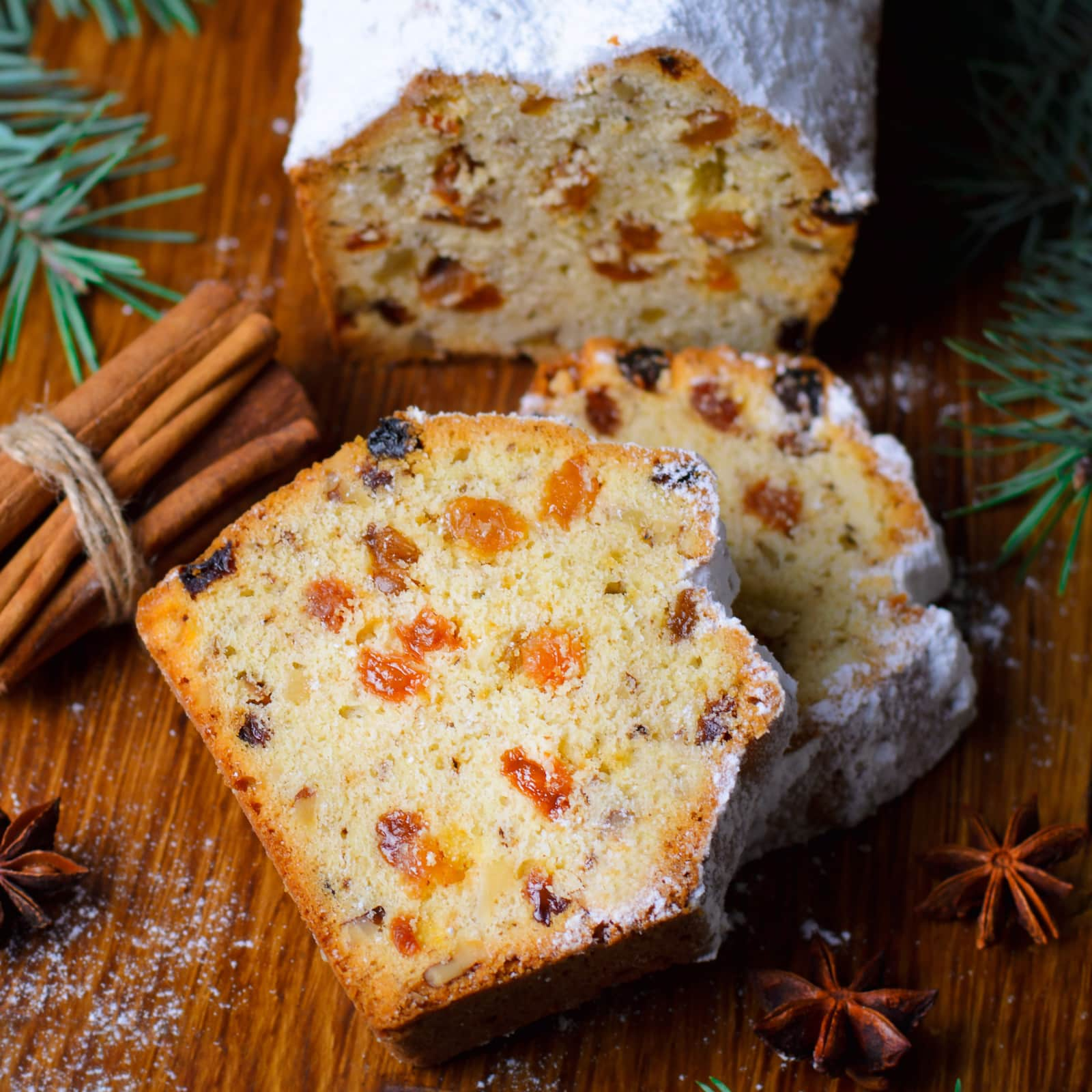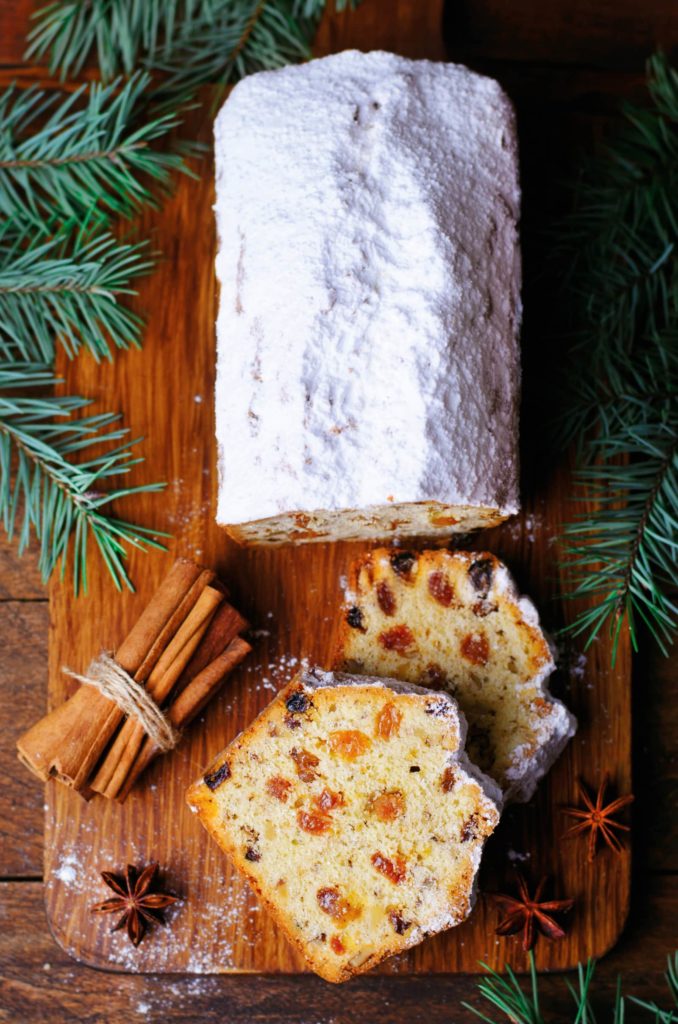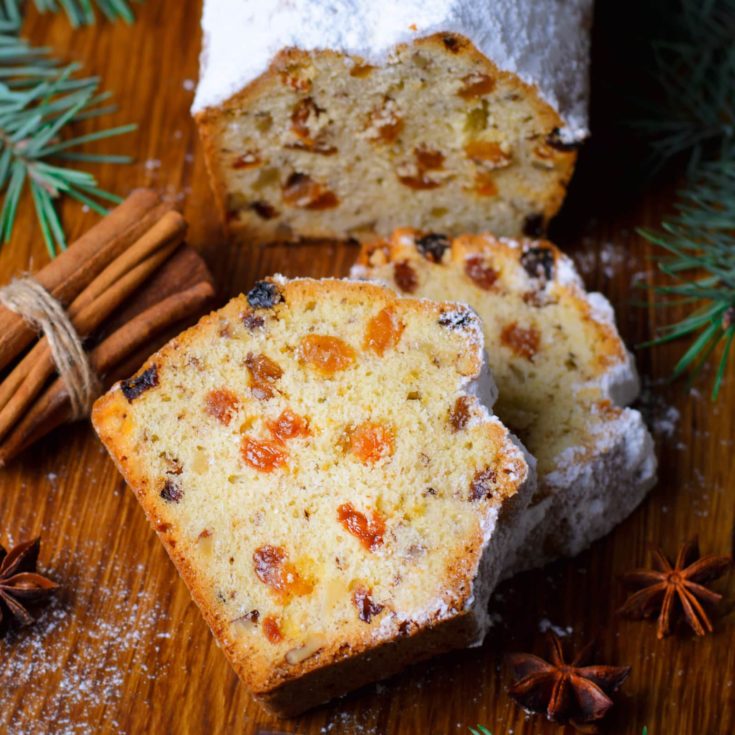Keks Świąteczny z Rumem
Keks: Christmas Fruit Cake
How to pronounce it?
kex
‘Play’ to hear:

Keks is a Polish-style fruit cake packed with nuts and dried fruit. The lightness and fluffiness of the sponge gets balanced beautifully by the richness and crunch of the toppings. A touch of rum adds that extra oomph.
For the full list of ingredients & detailed instructions, please see the recipe card at the end of this post. But before you scroll, there’s important stuff to know below.
This Polish-style Fruit Cake is made with a wealth of ingredients which, in recent history, would have been considered expensive and rare.
Keks is very similar to another cake known as Cwibak. The latter is a regional dessert, most known in Lesser Poland (Małopolska) – and contrary to Keks, it does not contain any additional fat. Both of them are most commonly baked in a loaf tin and it’s hard to tell them apart unless you bite in.
Do you need any special ingredients or equipment to make this Keks?
Most of the ingredients should be available in any major supermarket.
The only troublesome item might be the candied orange peel. Look out for it in the baking section of the store, get it online (e.g. on Amazon) or try making your own. Don’t worry though, candied orange peel is a great addition, but it’s totally skippable.
Dried fruit: You’ll need 6 oz (around 170 grams) of dried fruit mix. Traditionally, we mostly use cranberries, cherries, apricot and prunes, but feel free to use raisins, figs or any other fruit of your choice.
Nuts: You’ll need 4.5 oz (130 grams) of nuts. Most recipes for Keks call for walnuts and hazelnuts, but any type of nut would work well here.
Flour: Cake flour is best here (in Poland, we call it ‘tortowa’), but it can be substituted for the regular all-purpose flour. The recipe also calls for a few tablespoons of dark rye and potato flours, but if you don’t have them on hand – that’s okay, simply add more all-purpose flour instead.
Rum: Dark rum is best, but there are plenty of good choices here, you can try a liqueur or Polish nalewka (cranberry, orange, cherry or nutty spirits).
Equipment-wise, you’ll need a loaf tin, ideally sized at 12 x 4’’ (30 x 10 cm) or 9 x 5’’ (23 x 13 cm). You’ll also need a mixer for whipping egg whites, either hand-held or free-standing one.
What could you serve with this keks?
This cake is typically served on special occasions or the festive season, alongside other desserts. Some enjoy spreading some butter on a slice.
It pairs the best with hot beverages such as tea or coffee.
When selecting wine, try a glass of fizzy, citrusy Moscato or Riesling. For a heavier, sweeter vibe, opt-in for Port wine.
Can you bake this keks another way?
Sure you can!
- Different fried fruit and nuts: As I mentioned before, the exact selection is up to you.
- Make it fat-free: If you watch your fat intake, try Cwibak recipe instead (coming soon).
- Make a Chocolate Keks: Add 2 tablespoons of unsweetened cocoa powder to the flour, and 3.5 oz (100 g) of dark chocolate to the butter (melted and cooled beforehand).
What diets is this keks suitable for?
This recipe is suitable for vegetarians.
Don’t worry about alcohol in this recipe. After nearly an hour of baking, all that’s left in the cake is just the aroma. The percentages evaporate completely in the process.
How long can you keep this keks in the fridge?
There’s no need to refrigerate this cake. Just wrap it tightly in cling film, paper or aluminium foil to prevent it from frying out.
Store it in a cool place (e.g. pantry) for up to a month. If you live in a warmer climate, a fridge may be a better place to store it.
Can I freeze this keks?
Yes, this recipe can be frozen.
Once completely cooled, wrap the cake in cling film, and label it with a description and the date. Alternatively, you can portion the cake first and freeze individual slices (in cling film or freezer-friendly containers with a lid). Aim to consume within 3 months.
To thaw, leave the cake at room temperature overnight.

Keks: Polish-style Christmas Fruit Cake

Ingredients
- 6 oz (170 g) assorted dried fruit, unsweetened; e.g. cranberry, cherry, apricot, prunes, raisins
- 4.5 oz (130 g) assorted nuts: walnuts, hazelnuts
- 3 tablespoons candied orange peel; optional
- 1 ⅕ cup (5 oz, 140 g) cake flour; can be substituted with all-purpose flour
- 3 medium eggs
- ⅔ cups (120 g) cane sugar; or brown sugar
- Pinch of salt
- 1.5 stick (150-170 g) butter, unsalted
- 5 tablespoons (40 g) dark rye flour, wholegrain; can be substituted with all-purpose flour
- 3 tablespoons (30 g) potato starch or potato flour; can be substituted with all-purpose flour
- 1.5 teaspoon baking powder
- 0.5 teaspoon baking soda
- ⅓ cup (3 fl oz, 75-80 ml) milk
- ¼ cups (2 fl oz, 50 ml) dark rum; can be substituted with nalewka or liqueur (cranberry, orange, cherry, nuts)
Citrus Glaze (optional)
- ½ cup powdered/icing sugar
- 1.5-2 tablespoon citrus juice (lemon or orange)
- A handful of candied orange peel or chopped citrus zest, for sprinkling
Instructions
[30 minutes before baking]
Take eggs, milk and butter out of the fridge. Butter has to soften before we start.
Cake
- Chop all dried fruit and nuts: for more interesting and varied texture, chop a part of them finely, and the other part - more coarsely. Raisins and cranberry can be kept whole.Coat in flour and set them aside.
- Separate yolks from egg whites. Whip egg whites with sugar and a pinch of salt until stiff.
- Fold in egg yolks and soft butter.
- Sift all of the flours, baking powder and baking soda into a bowl. Gradually add the sugary-eggy mix and combine everything with a spatula.
- To finish off, add milk, rum and flour-coated dried fruit and nuts. Stir everything together thoroughly for even distribution.
- Preheat the oven to 330°F (165°C) with fan-assist, or 350°F (175°C) without.
- Line the loaf tin with parchment paper. Alternatively, you can grease the tin instead.
- Move the dough into the loaf tin and place it onto the middle shelf of the oven. Bake for 50-55 minutes. Test for doneness by inserting a toothpick into the cake. If it’s wet and the crumbs stick to the toothpick, it’s not ready yet.
- Take the cake out of the oven and leave it to cool down completely. Sprinkle with powdered sugar or cover with glaze as per instructions below.
Citrus Glaze
- Fill a small bowl with icing sugar, and add in the citrus juice. Blend together with a fork, until smooth glaze forms. If it becomes too liquid - add more icing sugar; if it’s too dry - ad more juice.
- Pour the glaze over the cake and sprinkle with chopped candied orange peel. Leave to set.
Notes
This recipe is adapted from the "Kuchnia Polska według Pawła Małeckiego" cookbook by Paweł Małecki. The recipe has been altered for accessibility and availability of ingredients.
Nutrition Information:
Yield:
8Serving Size:
1Amount Per Serving: Calories: 670Total Fat: 8gSaturated Fat: 2gTrans Fat: 0gUnsaturated Fat: 5gCholesterol: 54mgSodium: 224mgCarbohydrates: 137gFiber: 12gSugar: 39gProtein: 15g
Polonist is reader-supported. When you buy through links on our site, we may earn a small affiliate commission. Learn more
Recipe Information
Filed under:
Alternative traditional/regional names:
Also known / Misspelt internationally as:
Polish Fruitcake, Bakaliowiec, Cwibak, Ćwibak
Tested by:
First published on:
Recipe by / Adapted from:
Story by:
Bibliography / References: